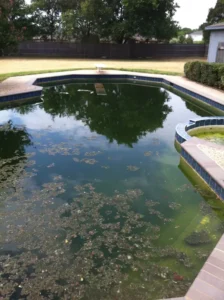61
Swimming Pools & Mosquitoes
Although Dallas County and Tarrant County have been all over the news recently with 262 & 218 human cases of West Nile virus (as of August 22nd), those of us in Denton County have not escaped, with 105 cases as of the same date. According to Bing Burton of the Denton County Health Department, this gives Denton County the highest rate (per capita) in the state for West Nile virus (source – WFAA Channel 8 news on August 22, 2012). This prompted Denton County Judge Mary Horn to declare a West Nile virus health emergency, which means that aerial spraying might not be far behind.
Although there are many factors which have contributed to this problem, stagnant water sources (including swimming pools) have contributed to this problem.
Swimming Pools

While we will never know the exact source of each individual case of West Nile virus, it is very likely that neglected swimming pools are partially to blame. A neglected pool means stagnant water, which is a breeding ground for mosquitoes to lay eggs that can produce thousands of mosquitoes in just a few weeks.
Owning a swimming pool carries with it a responsibility to provide care and maintenance for the pool. Operating the filter and keeping the water chemistry in balance is the solution, but that does not always happen. As a matter of fact, there is no better solution than to just maintain the pool. Even in extreme situations that make it difficult to care for a pool – such as financial issues, absentee homeowners, foreclosed homes, etc. – pool maintenance outweighs the alternatives. Alternatives that have been used to help with the mosquito issue for swimming pools are:
Mosquito dunks – A mosquito dunk is a doughnut-shaped solid item that you put into a body of stagnant water and as it dissolves, it distributes bacterial toxins that kills mosquito larvae. One mosquito dunk lasts for approximately 30 days. There are two problems using mosquito dunks in pools – the first is that surface staining due to algae is a possibility, and the second is that the lack of pool clarity becomes a safety issue.
Mosquito fish – Although I have no experience with mosquito fish, they have been used with success in other parts of the country. Mosquito fish (Gambusia Affinis) are about the size of minnows and eat mosquito larvae. They were used in the New Orleans area after the Katrina disaster and have also been used in California during the foreclosure crisis. If mosquito fish are used, chemicals (such as chlorine) cannot be added. The same problems exist that exist with mosquito dunks – surface staining due to algae is a possibility and the lack of pool clarity becomes a safety issue.
Cover the pool – Another option is keeping water in the pool and covering the pool, though you must be sure that the pool cover does not hold water.
Draining the pool – This sounds like an easy solution, except that there are two problems with it. The first problem is that most pools are not designed to be drained and doing so can cause structural damage to the pool. Another problem is that it is very difficult to drain a pool and keep it completely drained – due to rain, sprinkler systems, etc.
Remove the pool – Although it might seem like an extreme solution, if you no longer use the pool and it has become a liability, you might consider removing the pool.
There are certainly pools in the Denton area in which have been neglected which continue to contribute to the problem. If you suspect that a neglected pool is contributing to the problem, you can call the City of Denton Code Enforcement at (940) 349-8743.
Other stagnant water sources
In addition to swimming pools, there are many other sources around houses that can contribute to the mosquito problem. The basic rule is that if it can hold untreated water for more than a few days, it can be a breeding ground for mosquitoes. Following are some of the other sources of stagnant water:
Bird baths – Although they are attractive and attract birds, they also attract mosquitoes. Because it is warm and untreated water, it is perfect for mosquitoes. The best solution would be to drain and clean bird baths every 2-3 days.
Fishponds & water features – Although they can be beautiful, fishponds and other water features can be ideal breeding grounds for mosquitoes, especially if they are stagnant. If you have a fishpond or water feature that is stagnant, it is best to drain it. You might consider using mosquito fish, as mosquito fish have been used in several parts of the country in larger fishponds and water features which are too large to drain.
Storm drains – Storm drains are obviously necessary, but they can become a problem if they do not drain properly. If you have a storm drain near your house, be sure that it is draining. If it is not, contact your local municipality and they will correct the problem. Also check the street gutters that lead to the storm drains, as they can sometimes hold water due to concrete curbs shifting.
Clogged rain gutters – Rain gutters are “out of sight, out of mind”, but many of them hold water for a few days after a rain. This could be due to debris that needs to be cleaned out or even possibly due to gutters not draining and needing repair or adjustment.
Tarps – Boat tarps, RV tarps, and tarps that cover other equipment oftentimes are capable of holding water. Be sure that these tarps are not currently holding water and then be sure to check the tarp for standing water after each rain.
Containers & miscellaneous – Most homeowners have containers (buckets, unused flower pots, etc.) and other miscellaneous objects (children’s toys, old tires, tree holes, etc.) that are capable of holding water, especially with the recent rain that we received. Be sure to turn over these containers to be sure that they are not capable of holding water.
As you can see, there are many stagnant water sources that have contributed to this mosquito problem, but if we all do our part we can make an impact to improve this current situation.




